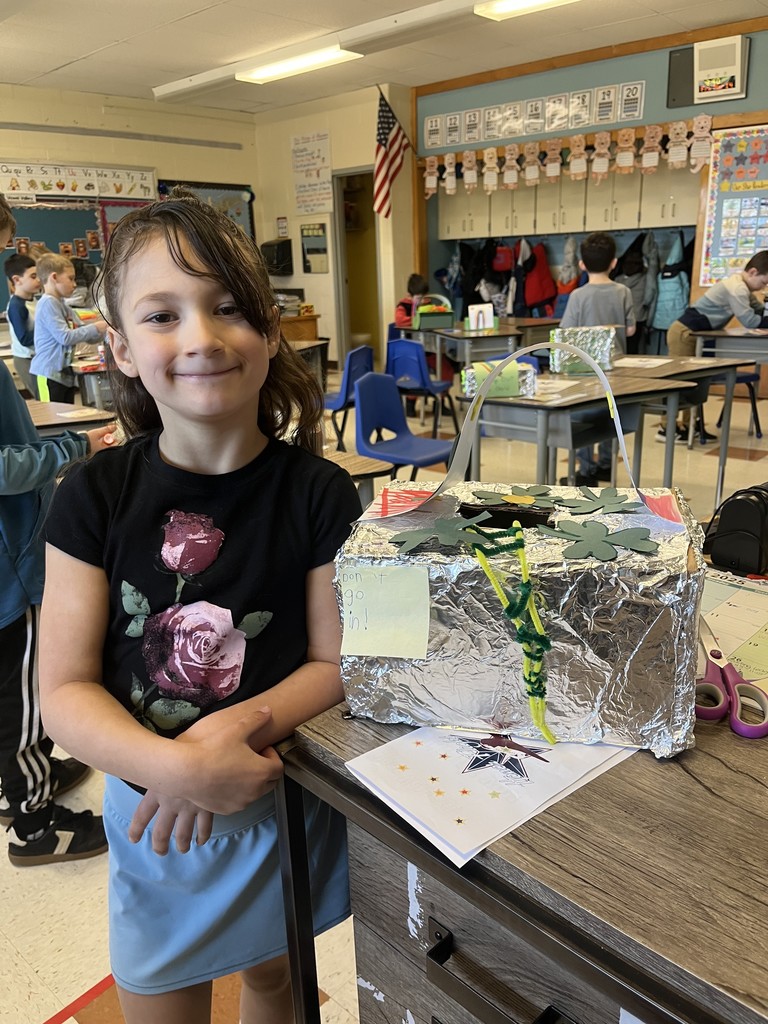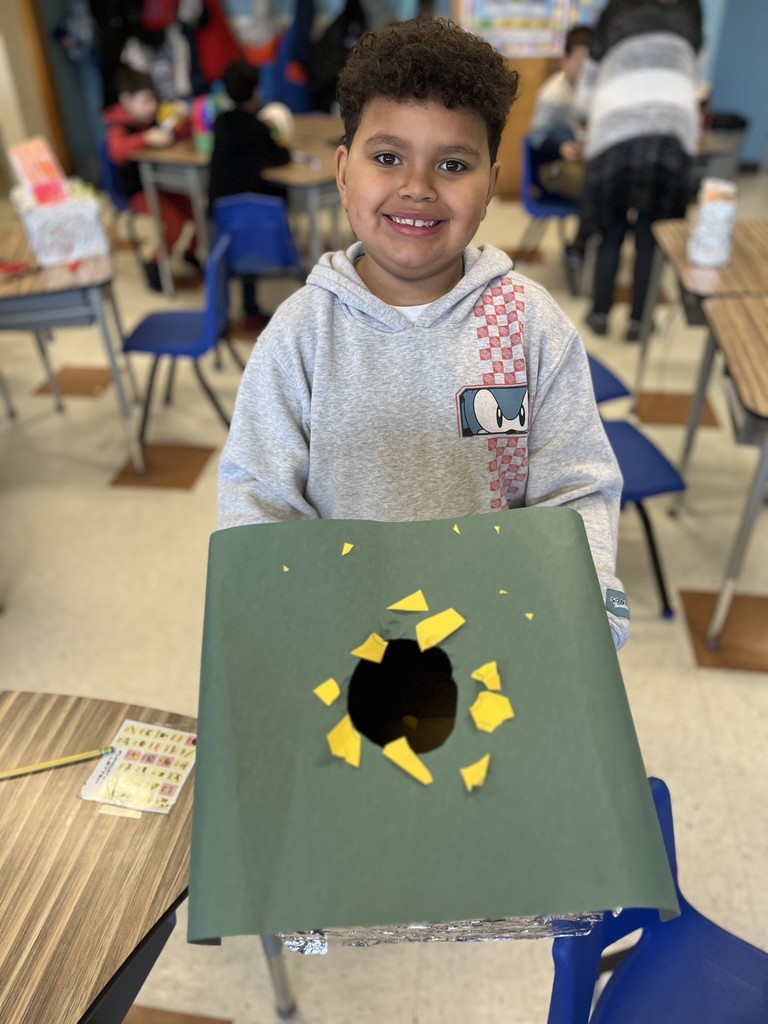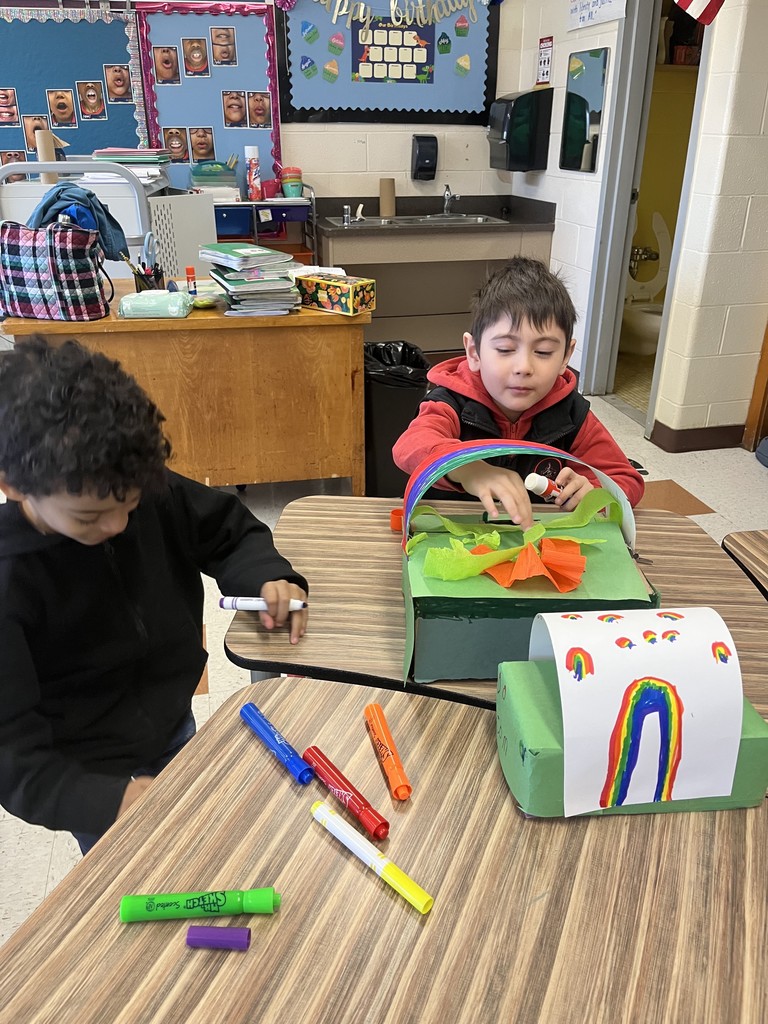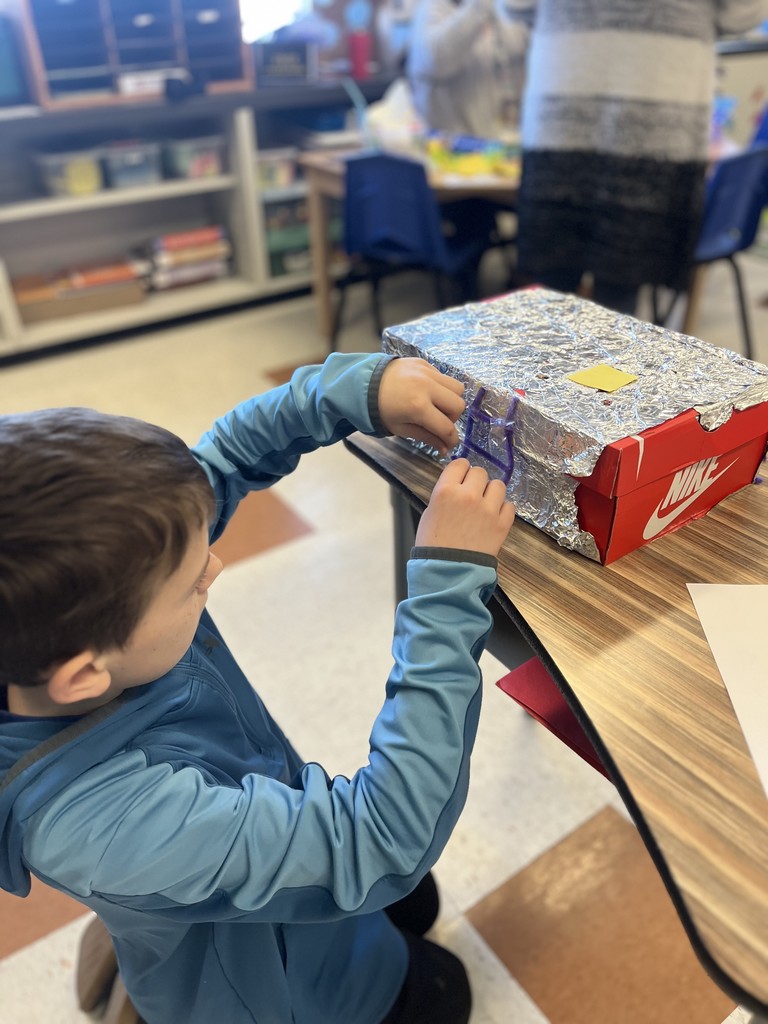Tasha Buchler’s Otisville second and third-graders are so “eggs-cited” to have six fertilized chick eggs in their classroom, and are on stand-by to welcome the soon-to-be born chicks, which have an estimated due date of April 1!
The eggs arrived on March 11 as a gift from Zoe Lockburner, the 4-H Livestock Program Manager at Cornell Cooperative Extension in Orange County. Ms. Lockburner recently visited their class to check on the eggs and to help students “candle” them. Candling an egg means shining a bright light through it to examine the contents, especially the embryo's development, and assess the egg's quality, fertility and viability.
Chick eggs have an incubation period of approximately 100 days. They’re staying warm in an incubator, set at 100 degrees, and are turned about 15 times a day to mimic what their mother hen would do.
As part of her visit, Ms. Lockburner read students Sauer’s “A Little Chicken,” the story of a chick who faces her list of fears one by one, ultimately catching a bouncing egg just as her new sister hatches. Thank you, Ms. Lockburner, for the visit!






Last Friday evening's Elementary School Family Folk Dance night was so much fun! We love seeing families gathering together to take part in activities...it's even better when students can show their families what they're learning in the classroom...in this case, it's music class!
Thank you to everyone who participated and a special thank you to ES Music Teacher Cliff Loretto for putting this evening together!

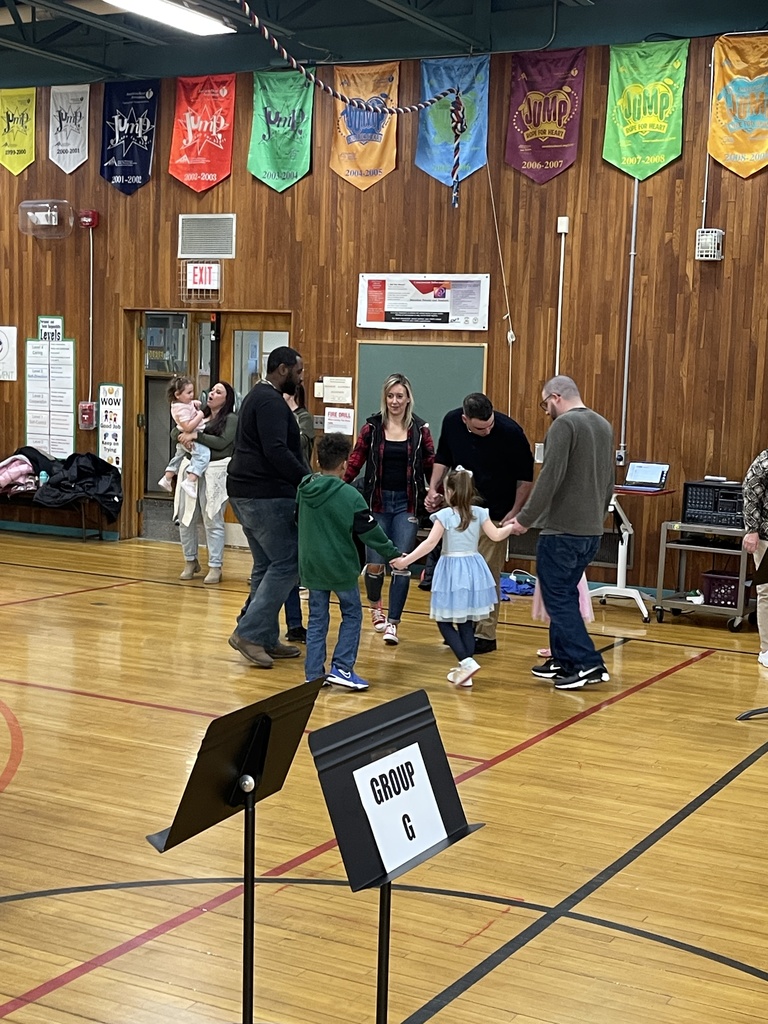
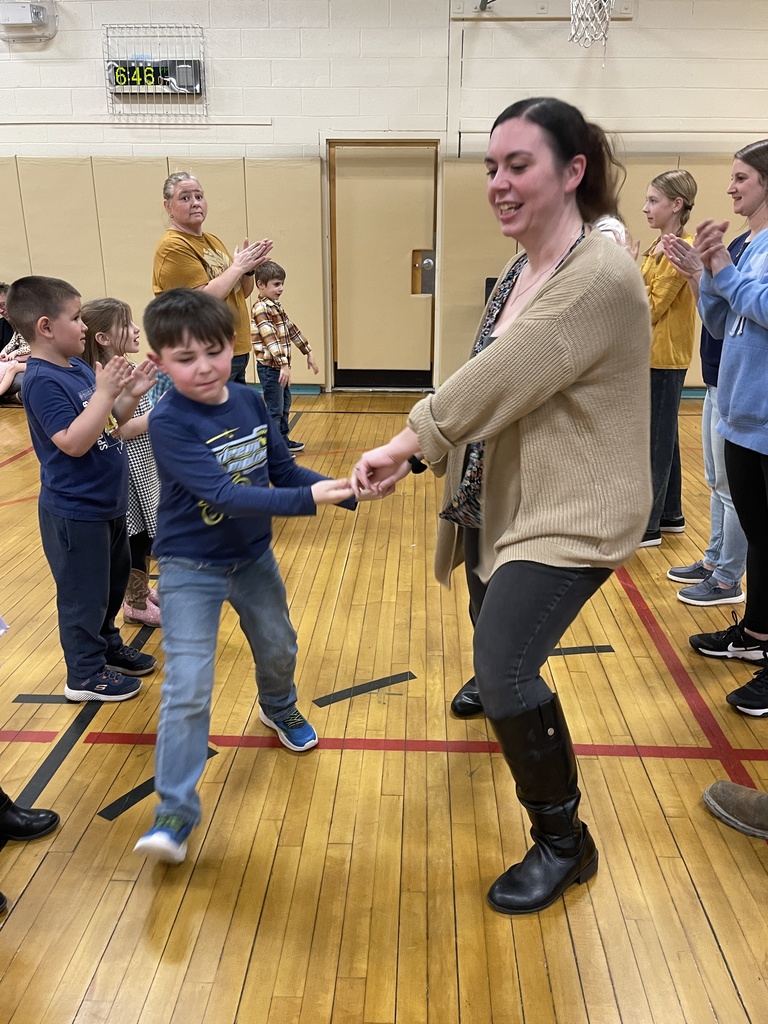

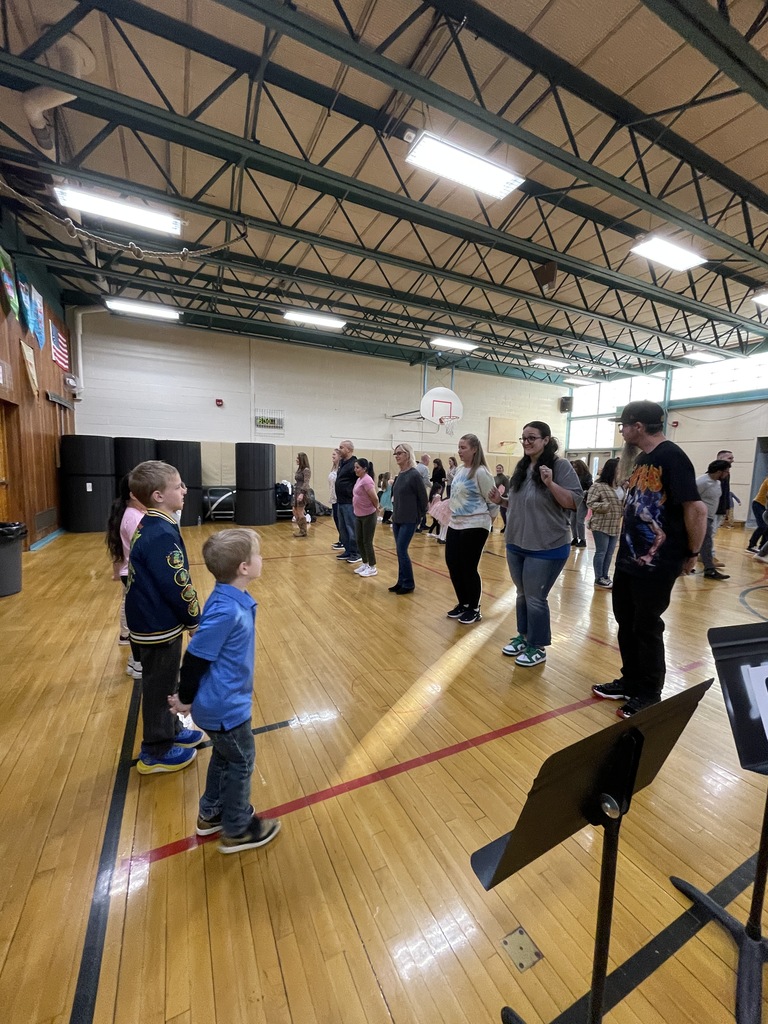
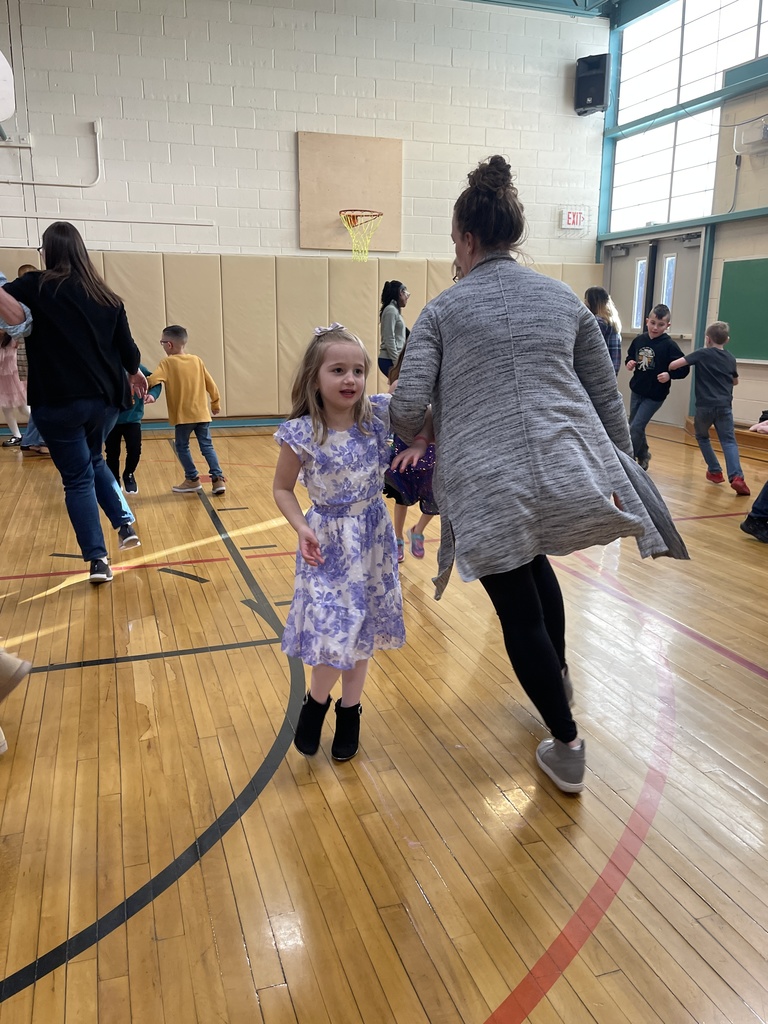

THANK YOU to everyone who attended and/or contributed in some way to Project Graduation’s March 22 Tricky Tray! The event raised enough to fund this year’s All-Night Graduation Party! Organizers said the evening was a huge success and they’re thankful for all of the donations made by families and local business as well as for all the volunteers who assisted in the evening’s success!

This recent Otisville Elementary lunch menu featured hot pretzels as part of the day's lunch offering! And it was a big hit, too! Take a look! REMEMBER, breakfasts and lunches are free to everyone! Please encourage your student to try both, and as an added perk, there's two less things for you to take care of each school day!
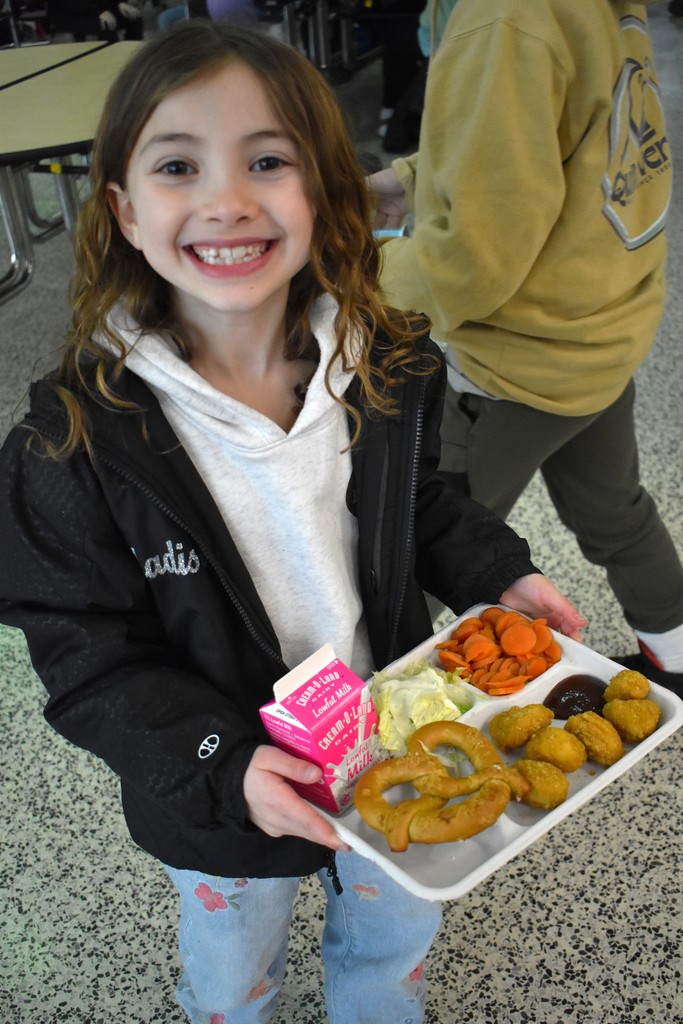

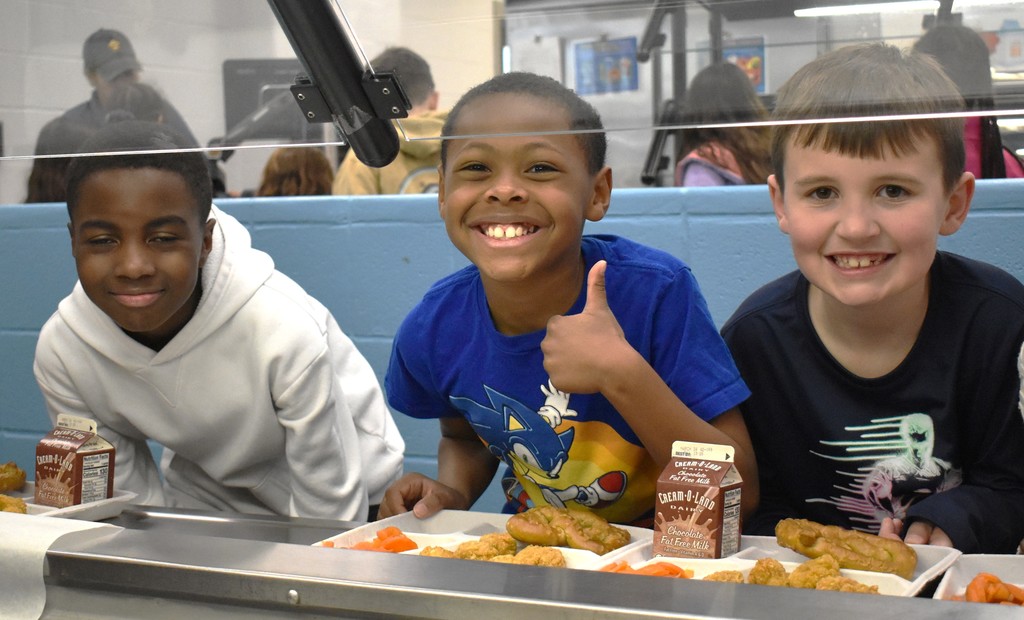
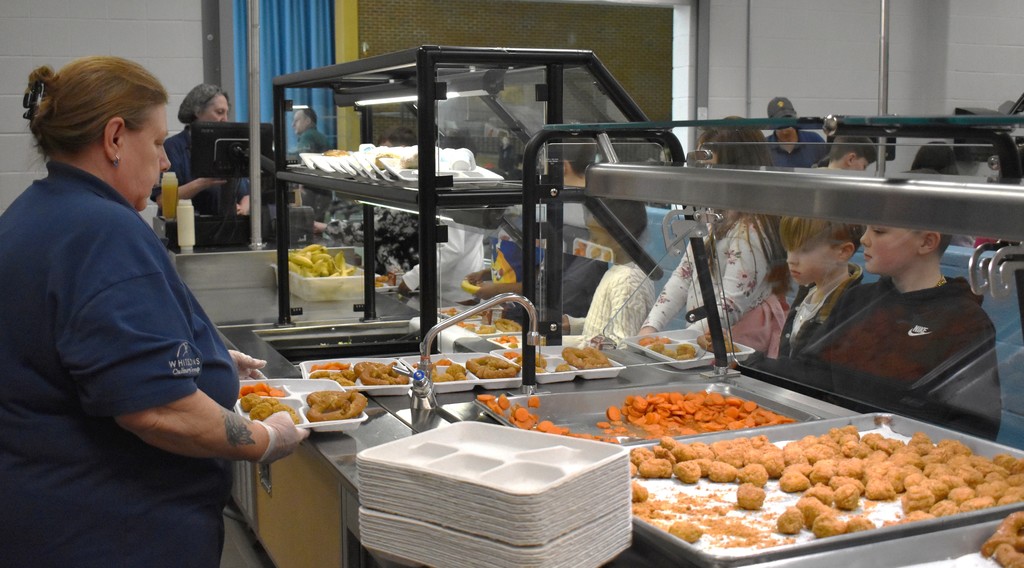
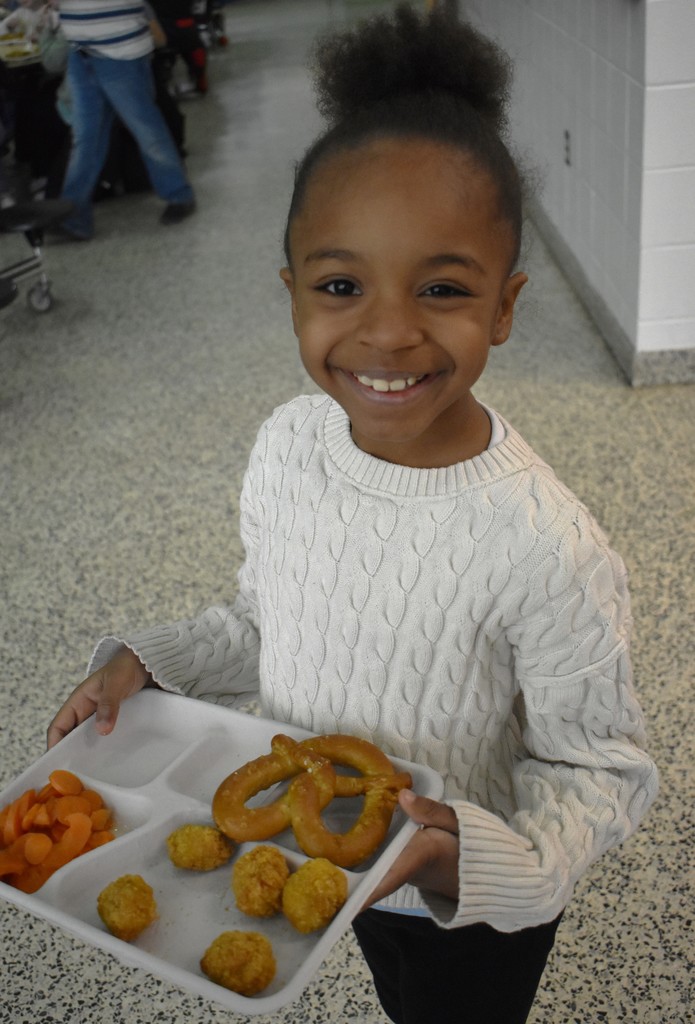
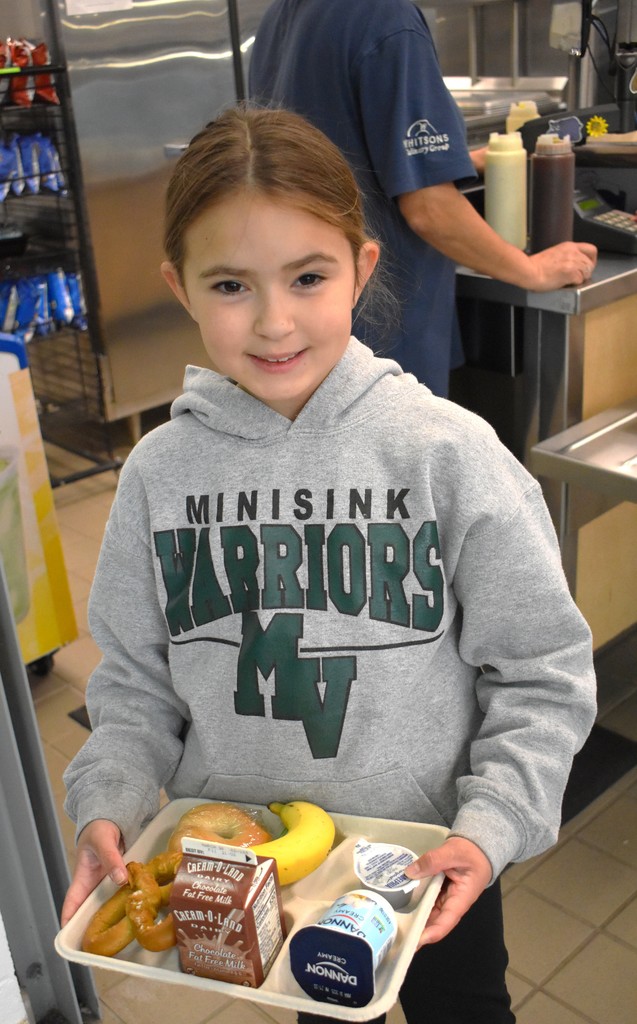
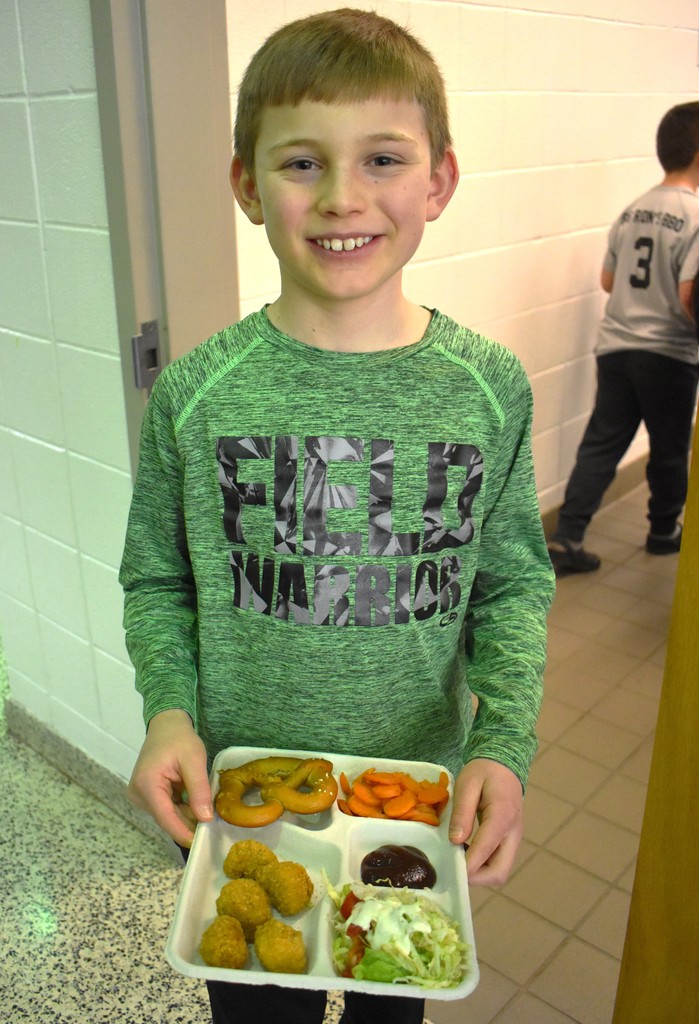
Kudos to the Minisink Valley High School Mock Trial Team, which was one of 13 school district teams participating in the first round of the State Mock Trial Tournament at Orange -Ulster BOCES on March 23!
For months, the mock trial team of Sean Bellew, Noah Haley, Morgan Varian, Landon Ordway, Malunga Kinzonzi, Josephine Witherow, Callie Hitt, Julia Wodzinski and Evan Washalski, guided by advisors Jonathan Grady and Ezra Clementson, prepared remarks focusing on a defamation case of a public figure to present their interpretation in a courtroom before a county judge. The team was also given valuable assistance from attorney consultants Michael Wolfs and Len Kessler---thank you to both!
To prepare for the tournament, each school has teacher-coaches as well as local attorneys working with them to help them with the nuances of the courtroom and presentation skills, an experience that cannot be duplicated in the classroom.
While the team is not advancing to the next level of competition, their tenacity and grit is certainly an example for everyone to admire! Well-done!


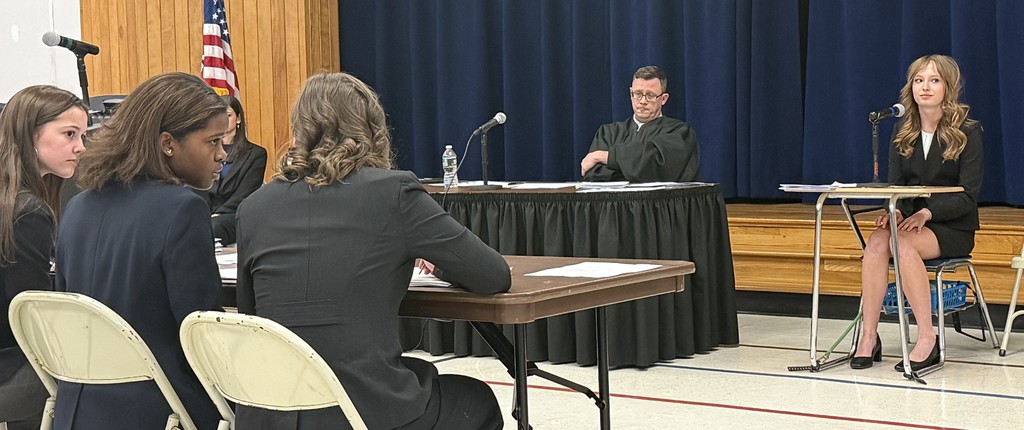


Guest readers from Cornell Cooperative Extension recently visited Otisville Elementary to read to students as part of their activities to mark Agricultural Literacy Week. Students were read a book about pumpkins and given a planting kit so they could plant pumpkins this spring! Thank you to former Otisville teacher Karen Krogslund, Gerda Krogslund and Ed Fairweather for stopping by!
Cornell Cooperative Extension's New York Agricultural Literacy Week (ALW), held annually in March, is a state-wide initiative that connects volunteers from the agricultural community with elementary school classrooms to share the story of agriculture through book readings and hands-on activities.





How do art and music and art manipulate emotions?
IS Music Teacher Deanna Feuerbach and IS Art Teacher Joan Giardina recently explored connections in music and art with their fifth-grade students in companion “specials” lessons! What a great, creative idea!
In music class, Ms. Feuerbach asked students to name three emotions that music can make one feel, or three things it can make on thing of. Then, she asked them to name three things in music that can have an effect on the feeling of the music.
Later, she spoke about the concept of synesthesia, which in music means experiencing music with other senses, like seeing colors when they hear notes or feeling a physical sensation from the music, rather than just hearing it. Some musicians and composers have a form of synesthesia that allows them to "see" music as colors or shapes. This is called chromesthesia. Mozart and Kandinsky are said to have had this form of synesthesia.
Students then took a look at Wassily Kandinsky's 1925 painting "Yellow Red Blue" that was painted in 1925. Kandinsky heard music when he painted with different colors and shapes, and he also felt different emotions for each color and shape he painted. In this activity, the students were able to interact with "Yellow Red Blue" on the promethean board, listening to Kandinsky's painting as he may have heard it. The different shapes and colors represent different instruments and emotions. The students were asked to describe the sounds and emotions they heard when playing with "Yellow Red Blue"
Meanwhile, in art class, Mrs. Giardina tasked her students to select four different types of “lines” and draw four color circles. For each she asked them to describe the kind of emotions they represented. She, too, spoke about synesthesia in art, which means experiencing one sense through another, like seeing colors when you hear music or smelling a color. It's a fun way to explore how brains connect different senses and can inspire unique artistic expressions.
Then they spoke about the applying their line designs to music. What emotions or feelings does it evoke? What comes to mind when thinking about the music. If they were to represent the feel of the music visually, what types of lines or colors would they use?
Then, they were tasked with sketching their ideas using thin, thick, straight, curved, solid and/or interrupted lines. Their work is amazing, and like in music class…. there’s no wrong thoughts or answers! Everyone sees and feels things differently!

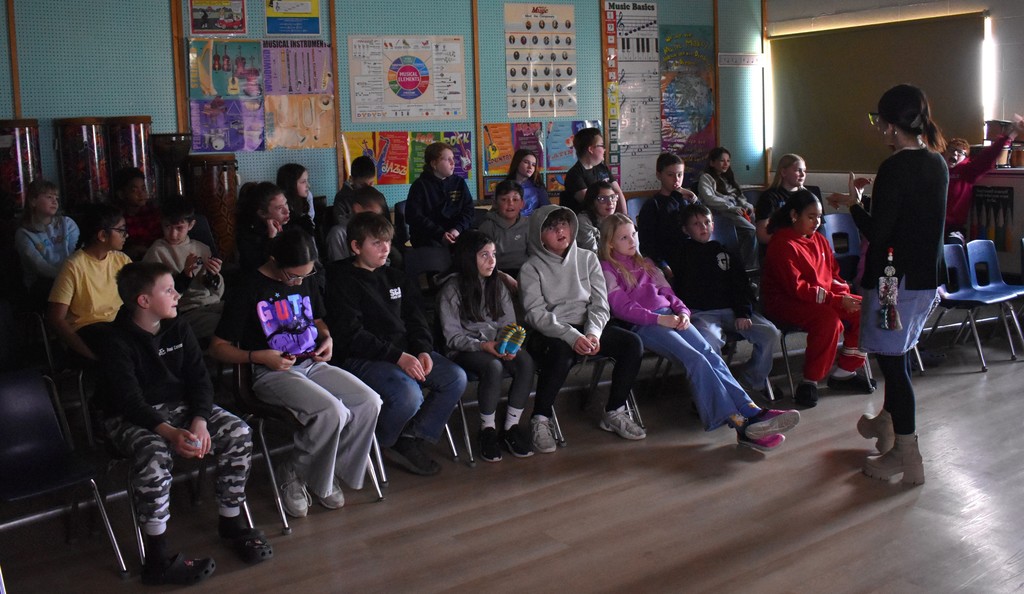
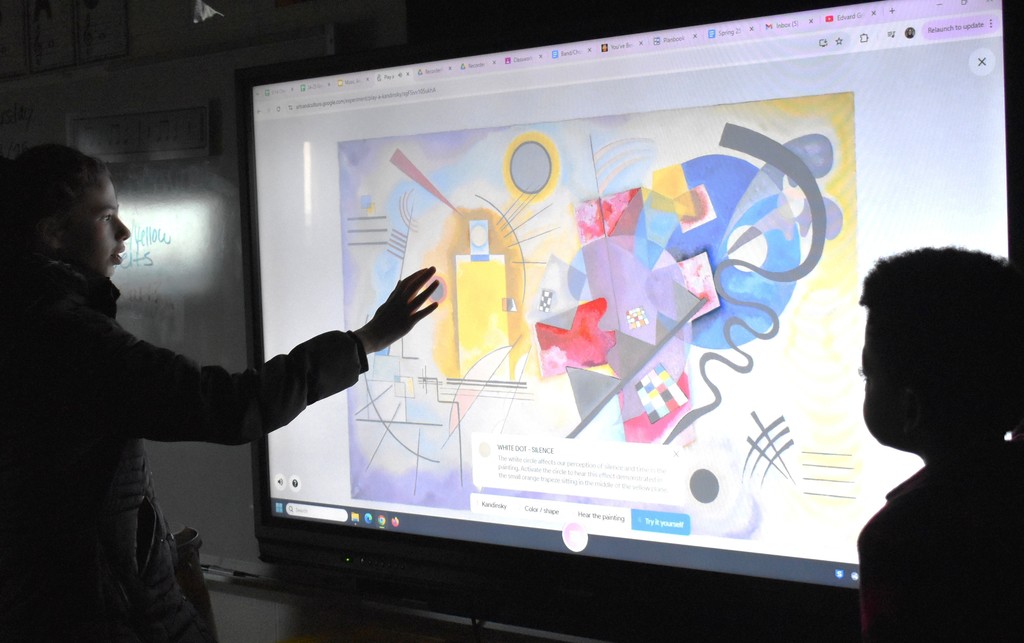
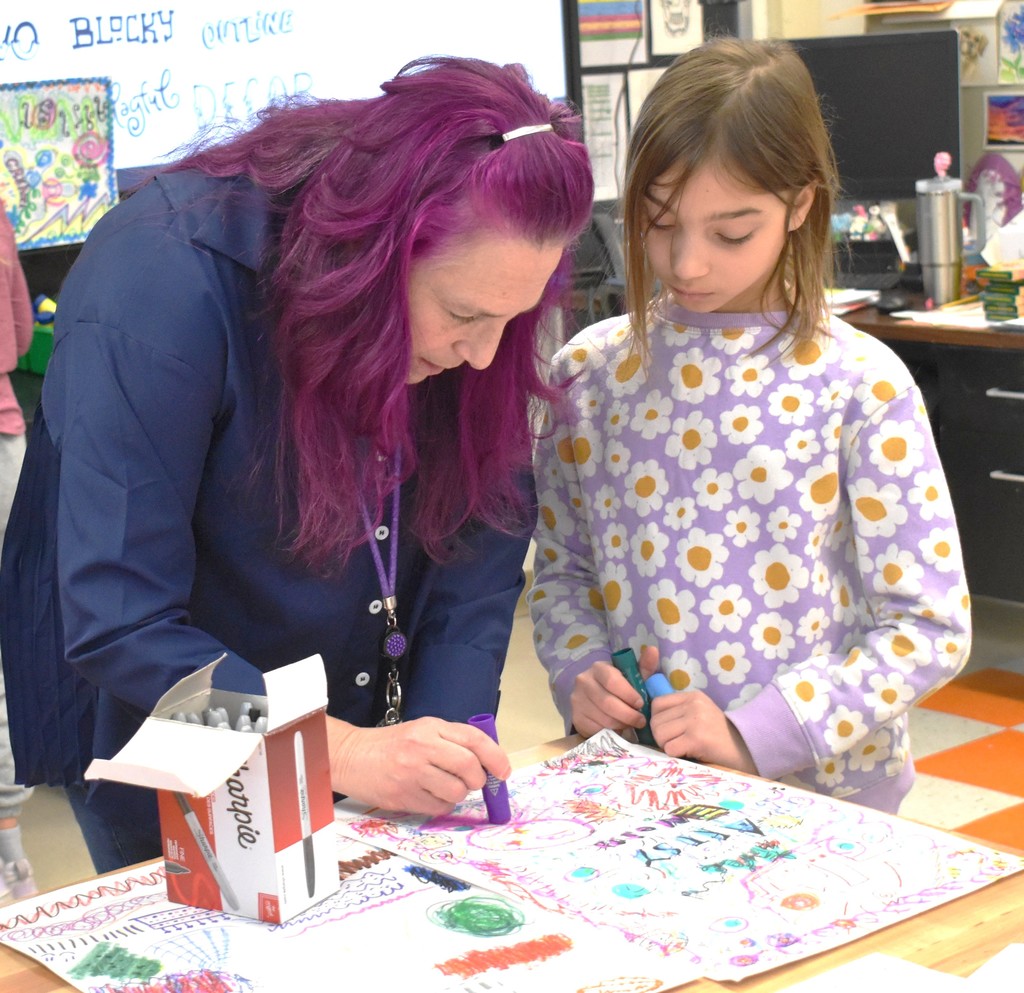
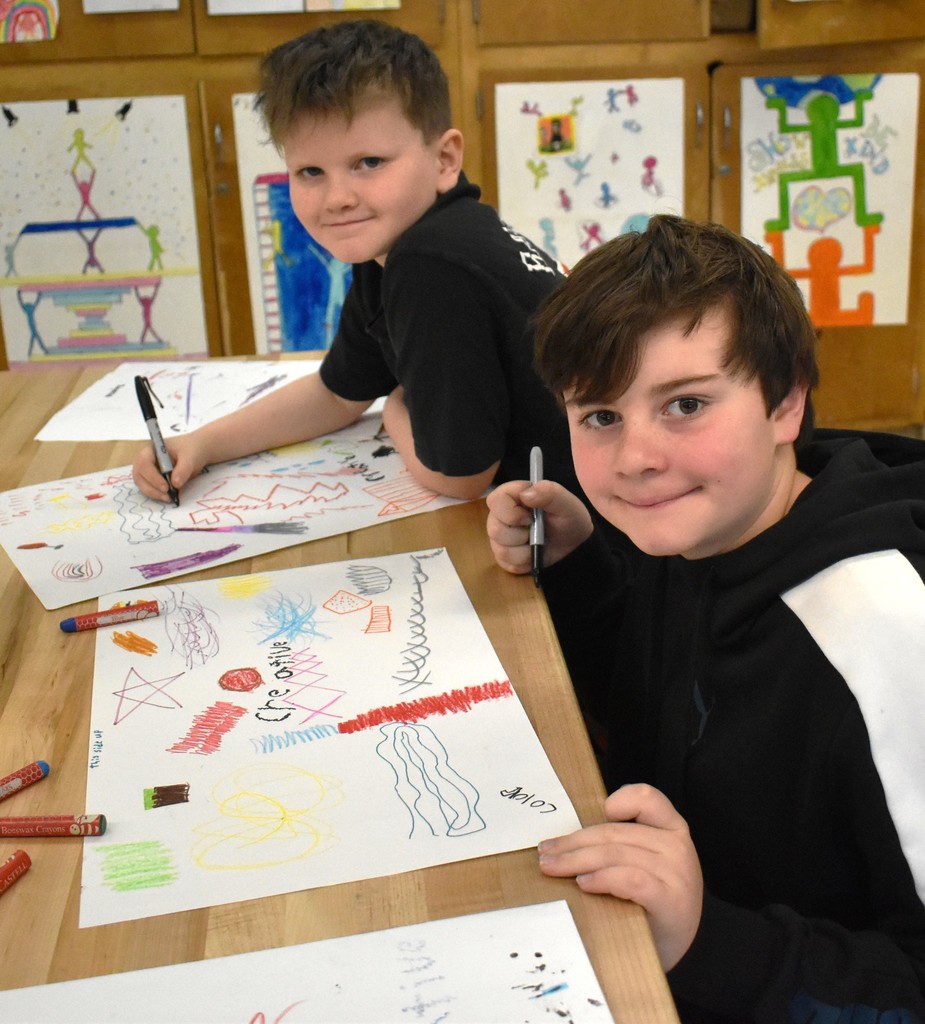


Leyla Johnson’s ES physical education students have been working on flexing and extending their muscles, moving through dynamic and static balances using different bases of support.
Students got to pick a letter of the alphabet or a number and try to create the shape of the letter or number with their body alone or with a partner. They had a lot of fun being creative and trying to guess what letters and numbers their classmates were making.
Then they got to try a variety of yoga poses and balances, along with working on mindful breathing to help them calm down and relax. They discussed how taking slow breaths in through their nose and out through their mouth can be helpful if they are ever worried, angry, upset or even out of breath from exercise to help calm down their minds and their bodies.
PLUS: As part of this, Mrs. Johnson’s music choices even looked to help set the mood for the class: Classic artists like Frank Sinatra, Nat King Cole, Ella Fitzgerald and Peggy Lee! Take a peek; these little ones were having a great time!
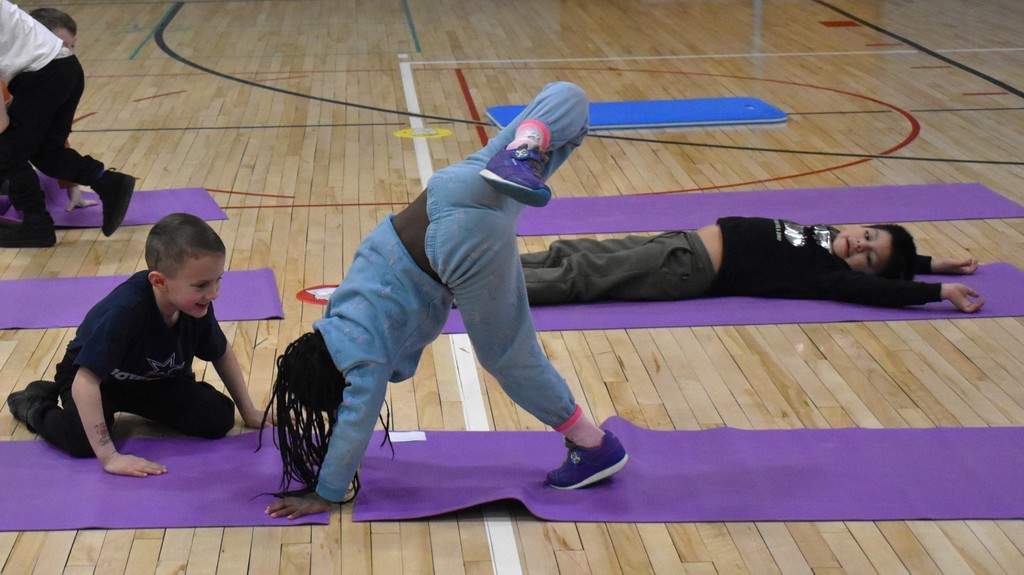
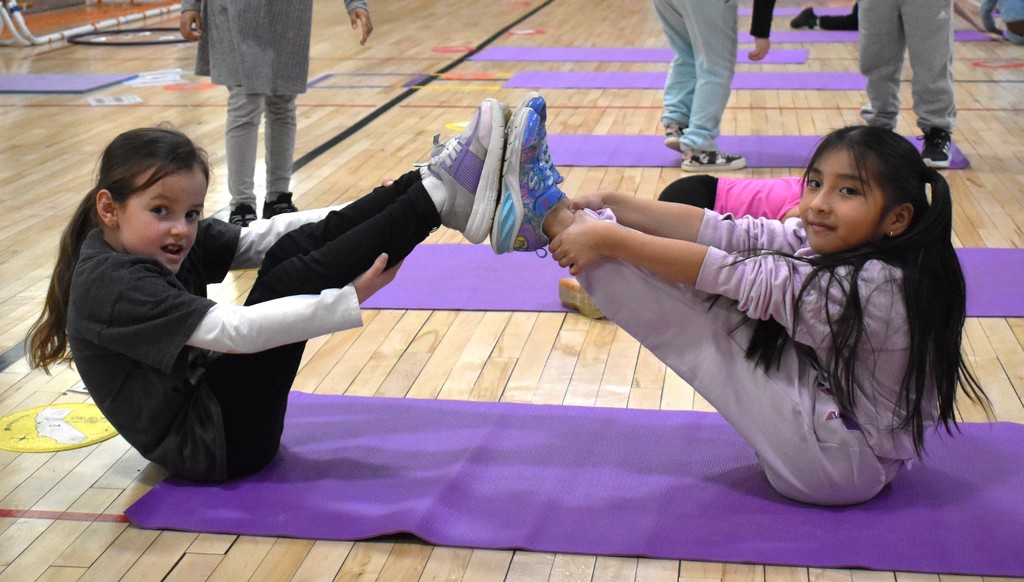
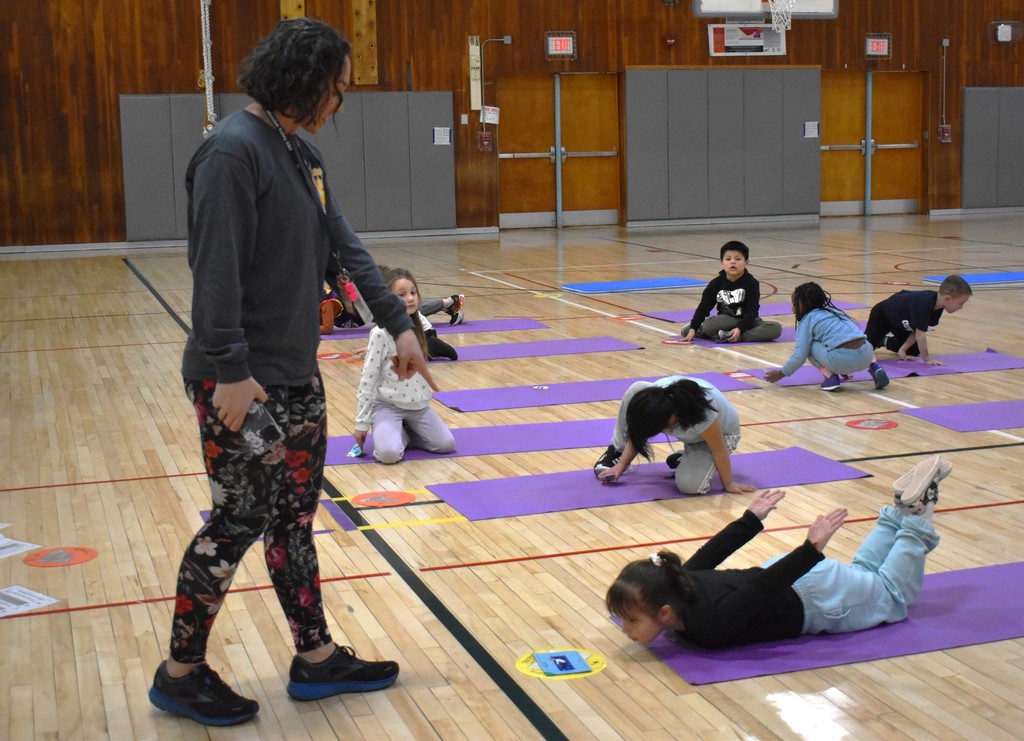
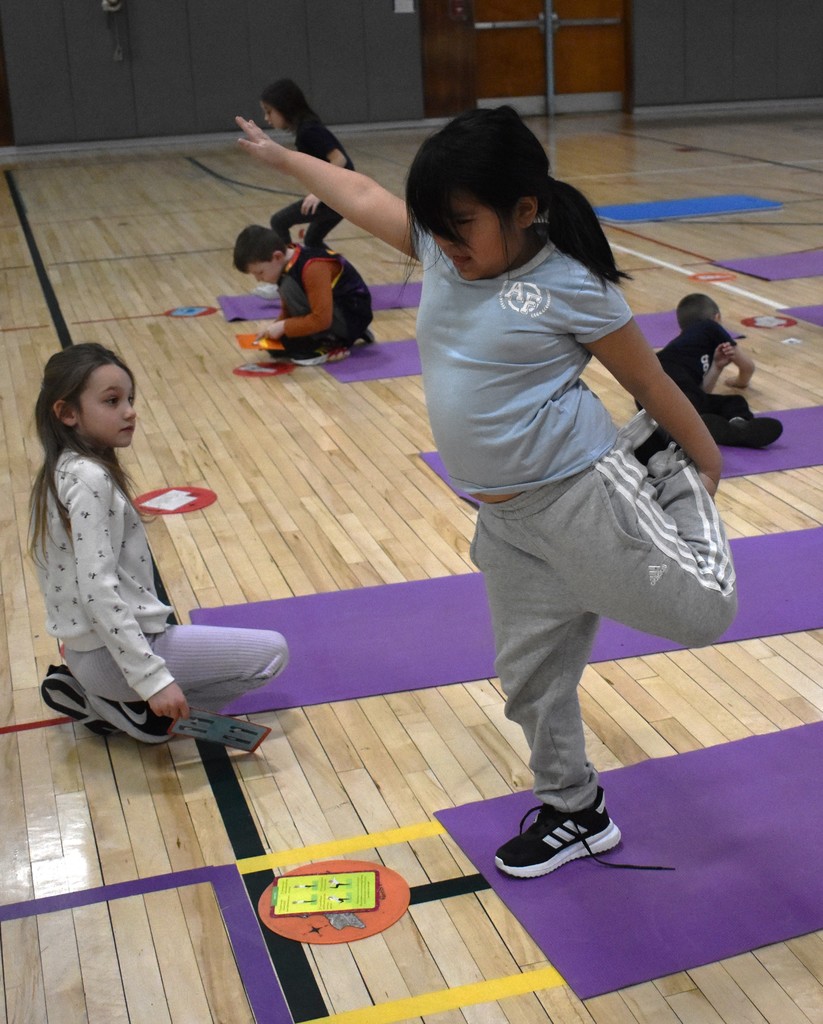
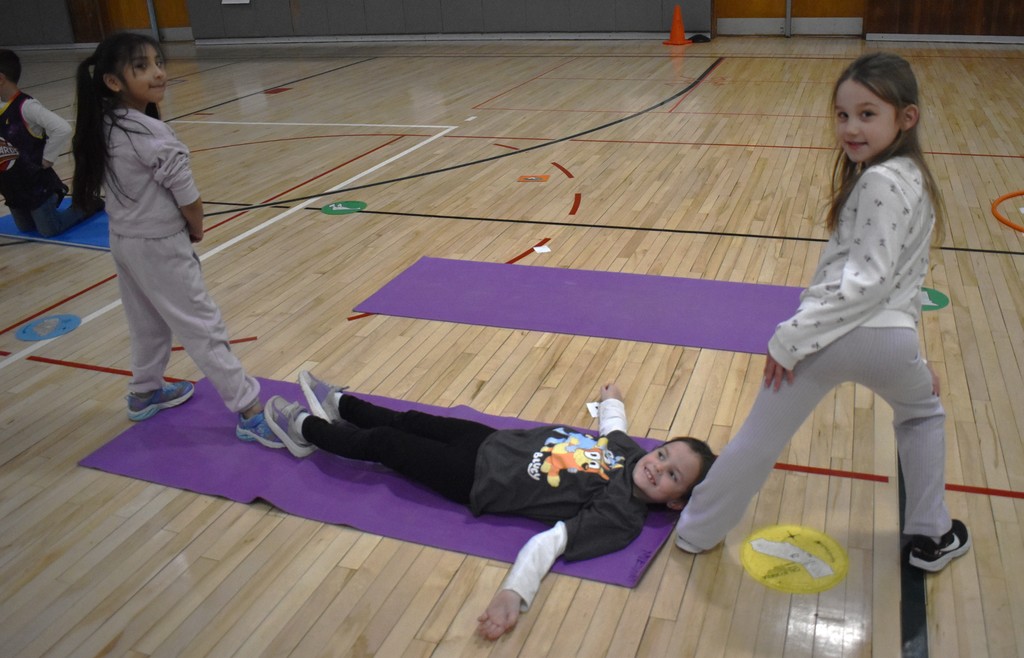
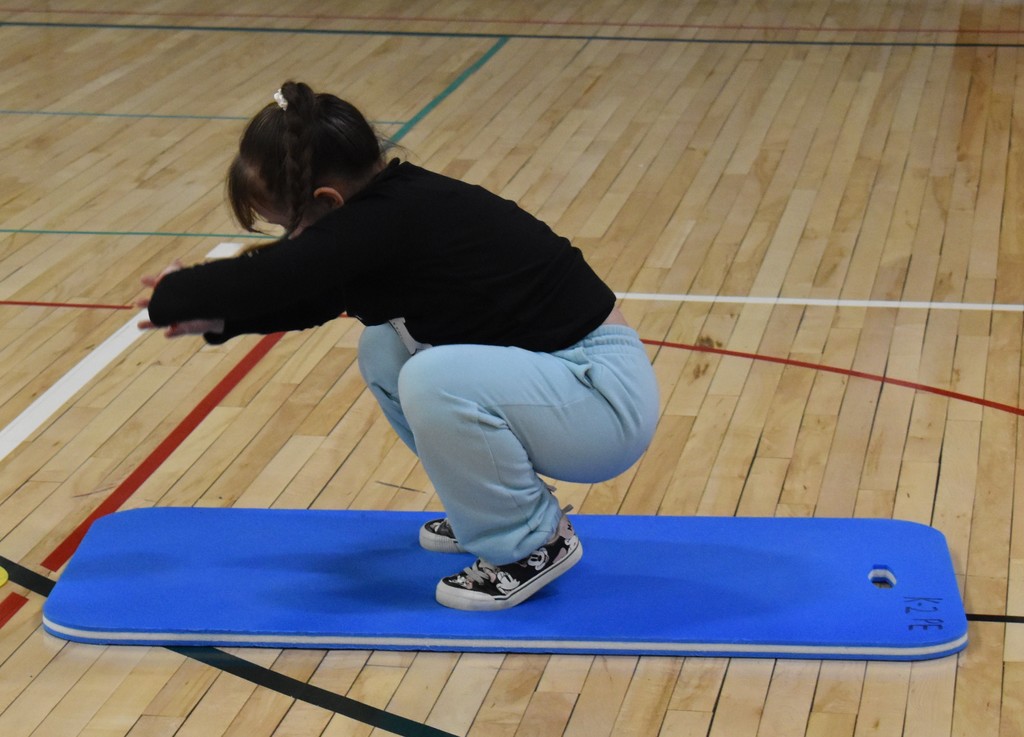
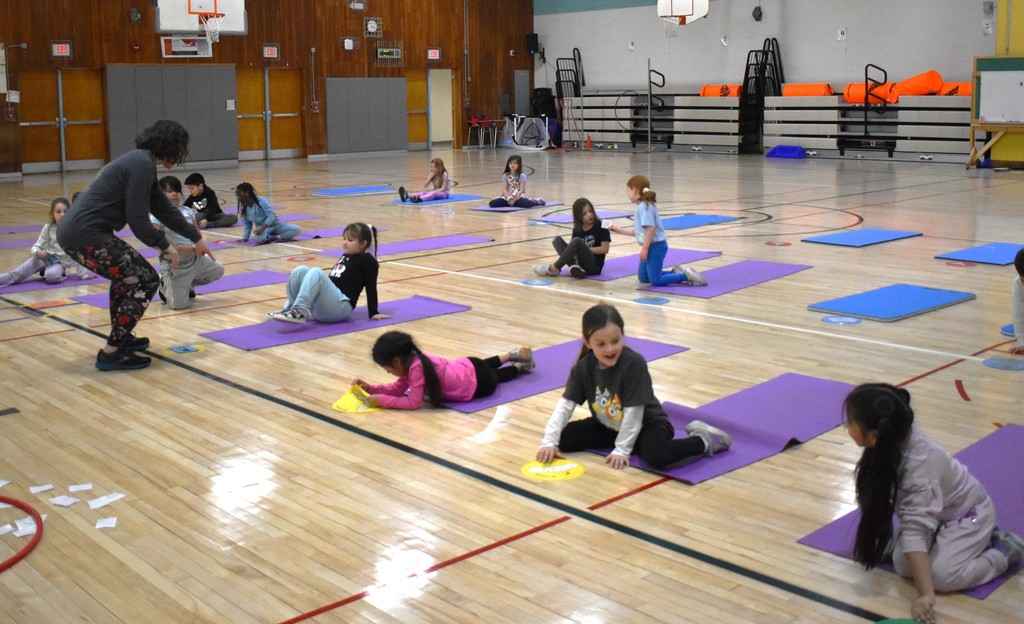
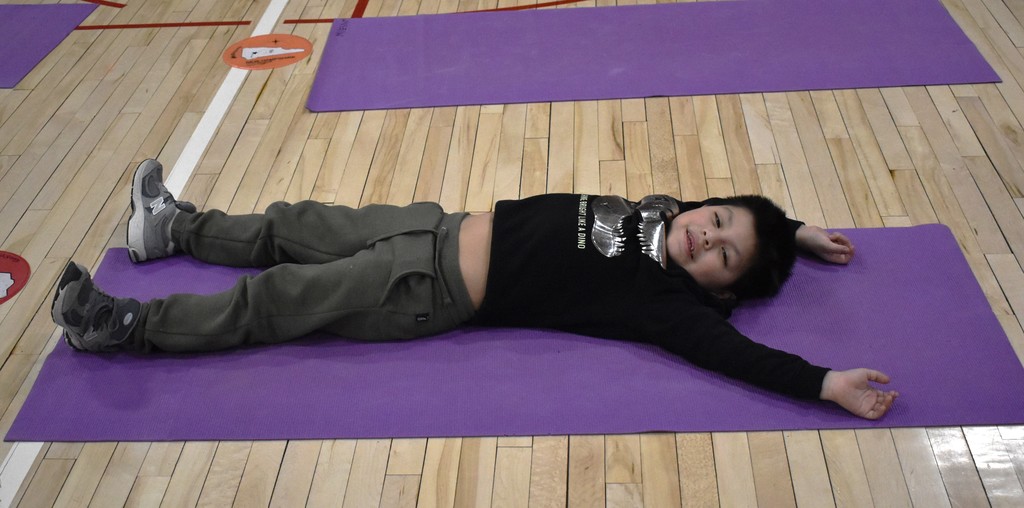
Sally Mankoo’s ES kindergarteners, like other district kindergarteners, have been learning about seasons and weather. In the last lesson of the unit, they learned a big word: Meteorologist! Students also learned about cumulus, stratus and cirrus clouds as well.
A project aligned with these lessons was the creation of “cloud spotters.” Students made their unique “spotters” so when they went outside, they could identify the type of clouds they saw. They glued the cloud pictures on their spotters decorated them with paint and other personalization items and used them during a recent windy day to identify the cumulus clouds in the sky! Take a look!
Cumulus clouds are puffy and white like cotton balls, while stratus clouds look like flat white sheets hovering overhead. Cirrus clouds come with rain-free weather and look like white wisps high up in the sky.




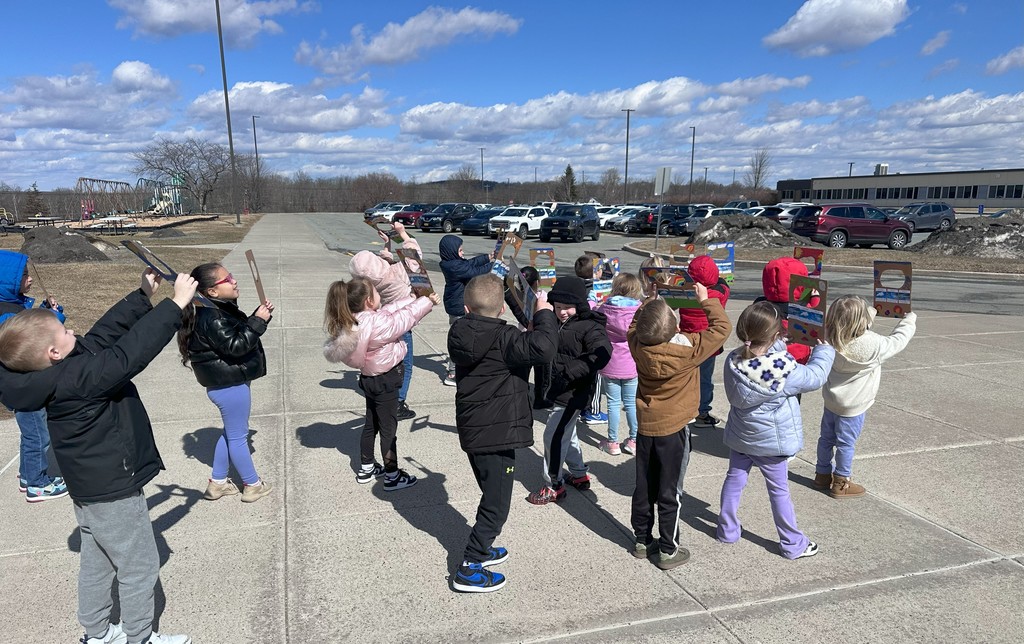
March is Women’s History Month, and IS Librarian Amiee Hardy was thrilled to find out that the IS Library won a Women’s History book bundle! These new books are welcome editions to the library’s collection! Remind your IS student these are great books to check out and read!
Women's History Month is a celebration of women's contributions to history, culture and society and has been observed annually in the month of March in the United States since 1987. The 2025 theme is “Moving Forward Together! Women Educating & Inspiring Generations.”


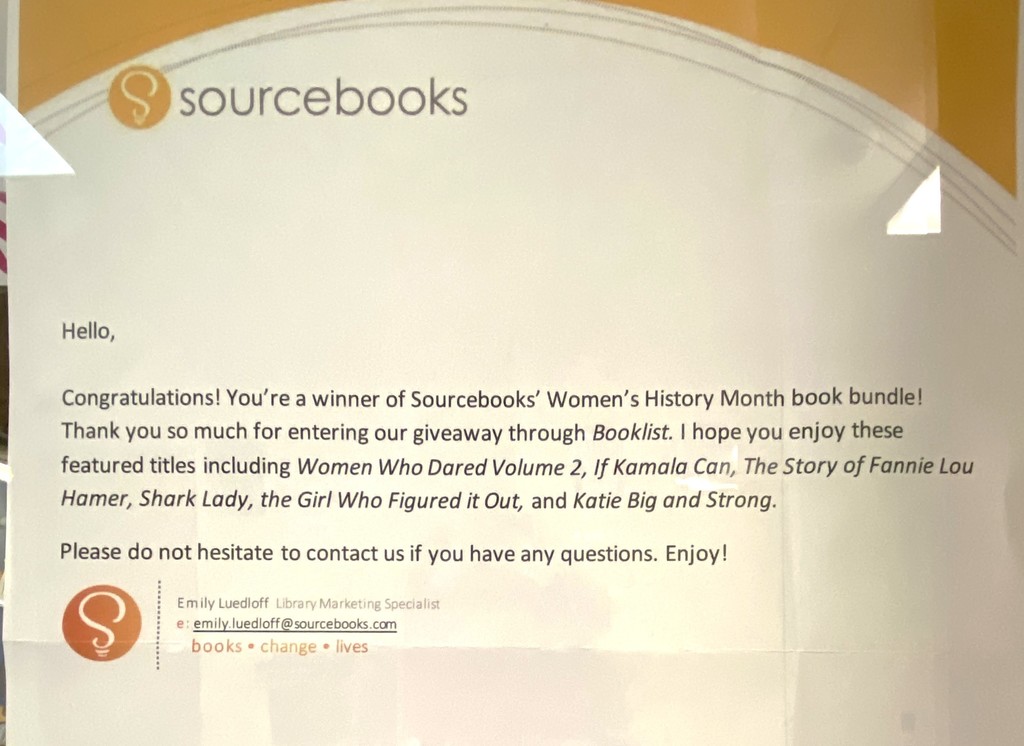

Christopher Tuthill’s High School technology classes activities sometimes expand beyond the curriculum for each class. Take a peek at Mr. Tuthill’s recent class presentations on the process of making maple syrup!
The goal of the demonstrations was to expose students to an activity that is unique to the northeastern United States and Canada while incorporating a STEM component to the lesson!
“We do cover types of lumber and tree identification in construction class and that was a part of my conversations with my students,” he said. “But there’s also a connection to science, technology, engineering and math as well throughout the syrup making process.”
Students learned about the history of maple syrup, tree identification, the process to tap maple trees, the boiling/evaporation process and more, including:
•Science: Students learned about the density of liquids, weather patterns, tree identification, parts of a tree (bark, sapwood, heartwood) biology- how a tree feeds itself to produce leaves each year (photosynthesize)
•Technology: Students learned the methods of sap collection, vacuum systems, evaporation processes and tools and machinery used, including the use of a hydrometer to understand sugar content
•Engineering: Students learned the methods of efficient sap collection and the process to make and bottle the final product
•Math: Students learned the ratios, or averages, for sap collected to final product made, sugar content percentage of both sap and finished syrup, boiling time, fuel consumption, tree diameter and circumference
It was the perfect STEM activity/lesson/demonstration for students to witness and participate in!
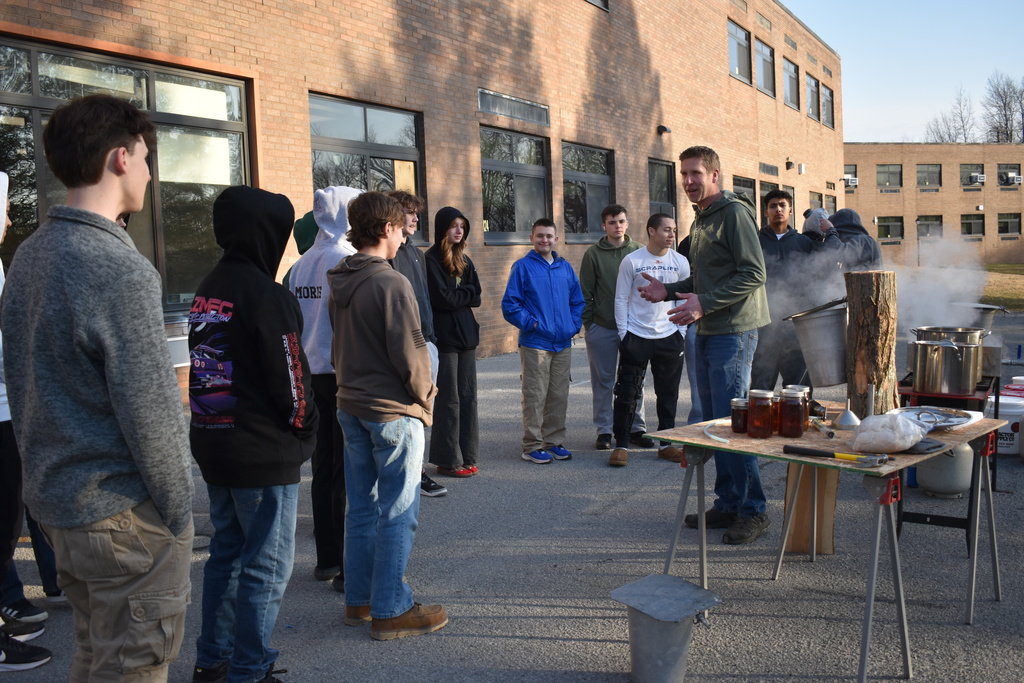


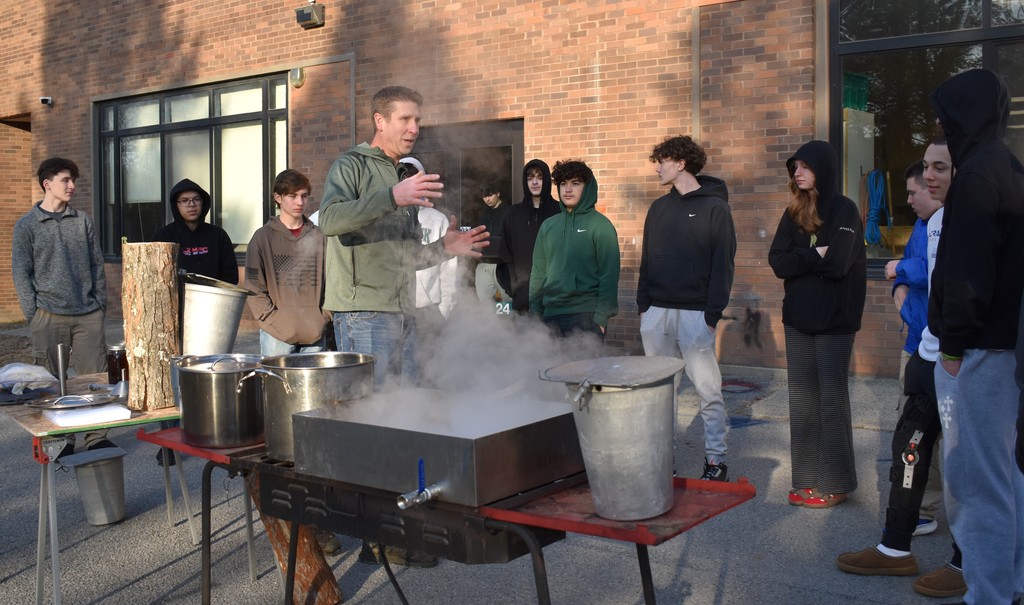
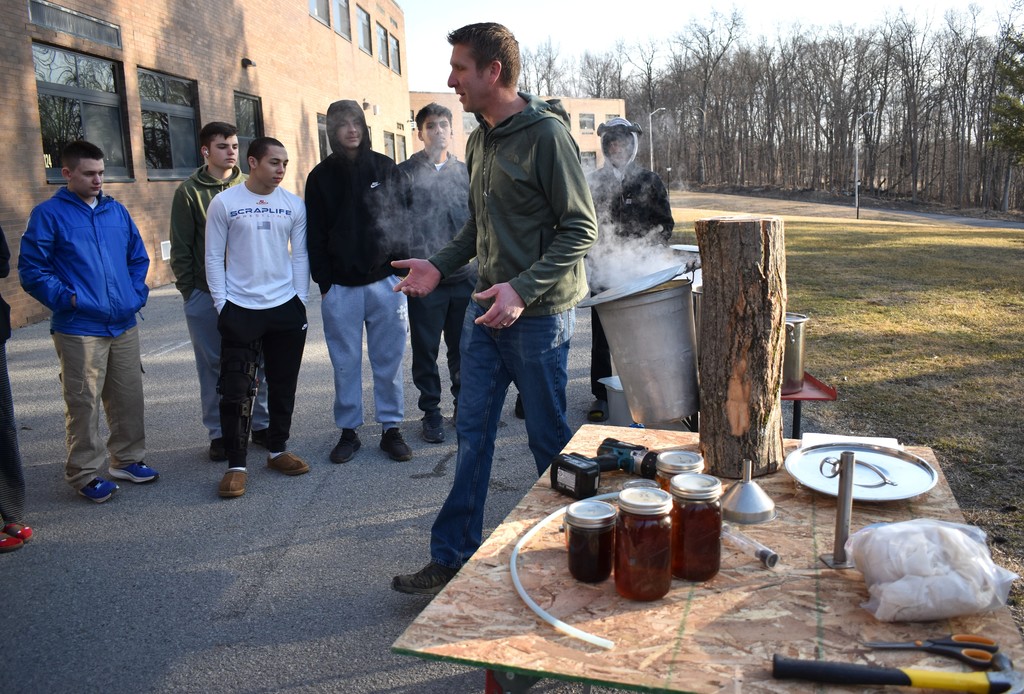
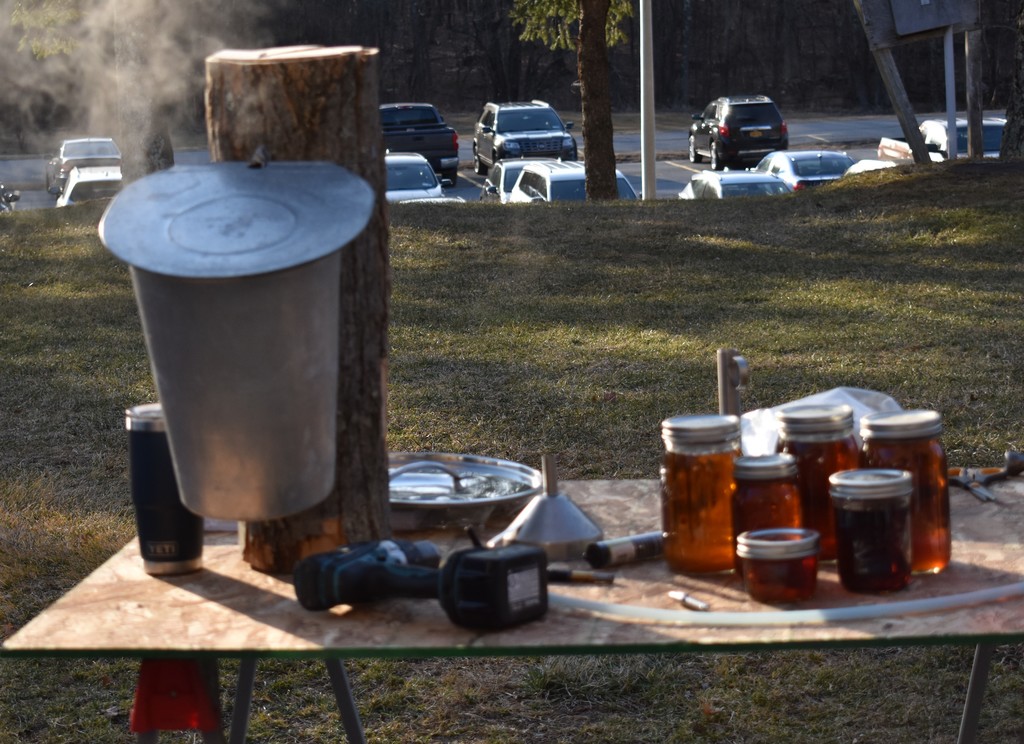

Ilana Kaufman’s second-grade art students grade students are exploring fiber arts by learning how to weave on a loom.
Here’s the fun part: Students made their own looms by painting paper plates with decorative line details! Students are using yarn and an “under/over” repetitive pattern to create a circle weaving work of art. Each design is beautiful and unique!
Paper plate looms also give students a chance to further build fine motor skills. There are even some math connections, too, as students have to think about measuring and pattern making.


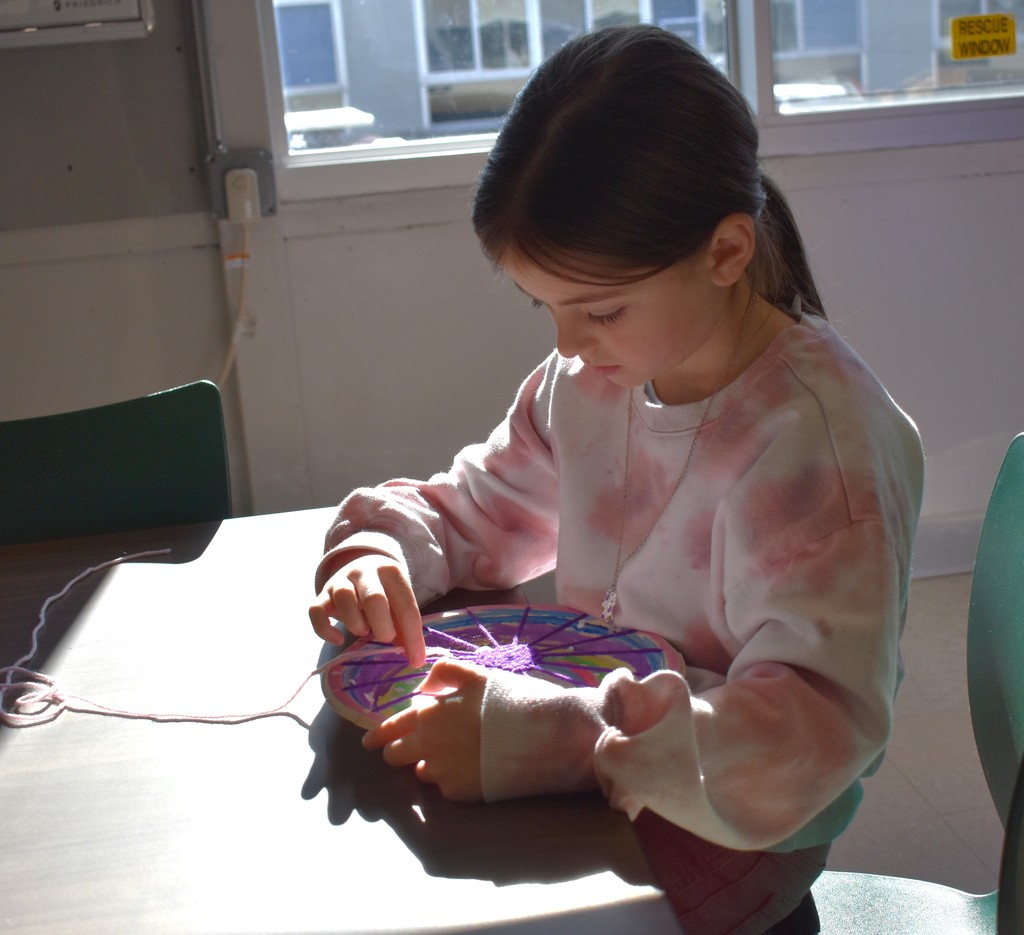
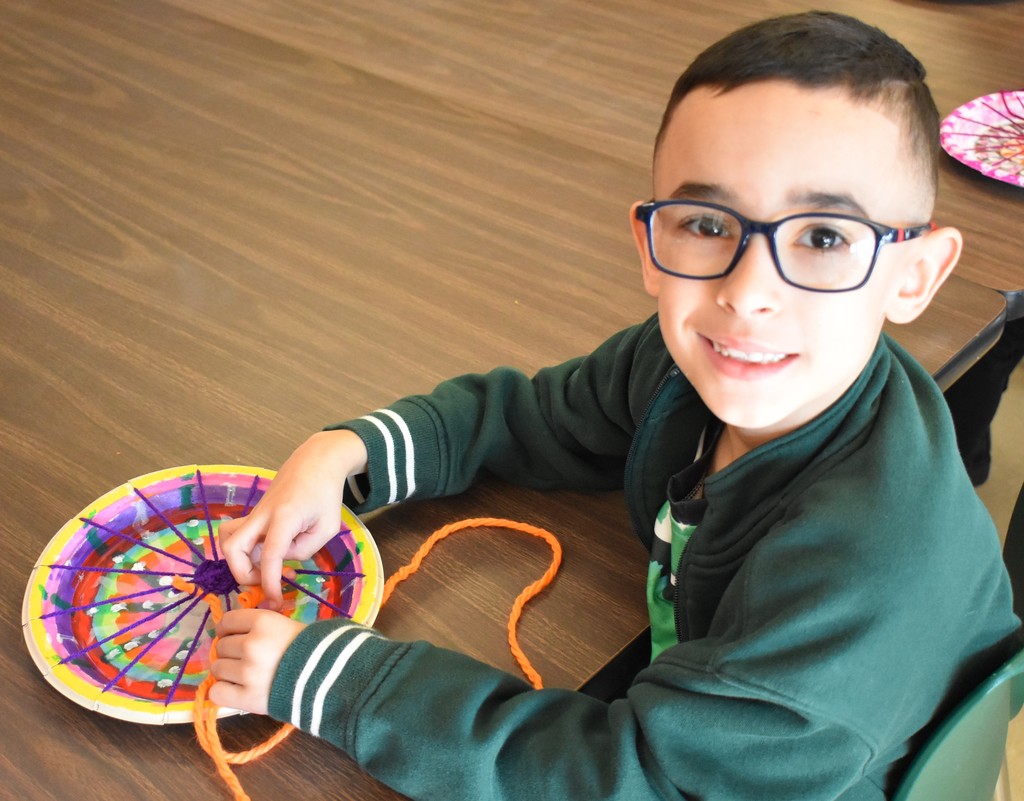


ARE YOU READY? IS YOUR BRACKET SET? MARCH MADNESS officially begins with a 6:40 p.m. tip off tonight when the St. Francis Red Flash meet Alabama State in the first of two “First Four” games.
But! Middle School Spanish classes have just completed their own MARCH MADNESS- type tournament today, March 18, with Spanish music called "Locura de Marzo!"
“Locura de Marzo” is a Spanish music tournament created by a group of Spanish teachers that takes place every March. It's similar to March Madness, but instead of college basketball teams, it's Spanish songs! This year, there are more than 215,451 students in 1,350 schools in all 50 states and 13 other countries, including the Middle School, who participated!
How it works:
•Spanish teachers around the world select 16 songs
•Each day, two songs compete against each other
•Students listen to the songs and vote for their favorite
•The winning song moves on to the next round, and the losing song is eliminated
At the Middle School, students all selected the songs that they liked in their own brackets and whoever had the most correct choices at the end of all of the rounds wins! Felicidades a los ganadores del soporte Maggie Pason y Lennox Addo!
What a great way to expose students to the Spanish language through music! Plus, “Locura de Marzo” also exposes students to new music styles and artists; helps engage students with real-world content; and helps students develop at cultural connection to different styles music!

ST. PATRICK’S DAY FUN: ROLLING FOR GOLD!
Kelly Bernice’s Otisville second-graders also had some St. Patrick’s Day-centric math fun playing several rounds of the “Rolling for Gold Math Game!”
Students rolled the dice, added the dice and then move along on the gameboard. They took turns rolling and adding. If they landed on “a Leprechaun’s hat” they had to move back several spaces on the gameboard. If they landed on a shamrock, they were able to move forward several spaces. Whoever reached the “Pot of Gold” at 100 won the game!
This fun game reinforced addition skills, promoted number sense and fluency and encouraged strategic thinking and problem-solving!






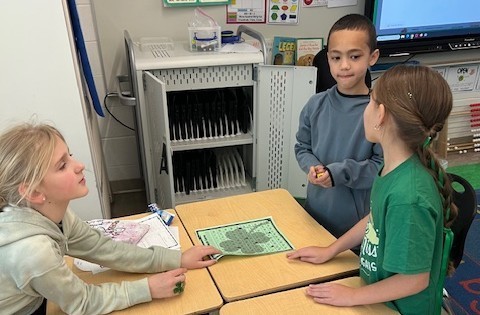
ST. PATRICK’S DAY FUN: MAGICALLY DELICIOUS MATH RATIOS!
Jacklyn Lockett’s sixth-grade math students completed some St. Patrick’s Day-centric math work focusing on ratios using Lucky Charms cereal!
Students categorized the cereal’s marshmallow bits by shape and then wrote ratios comparing the different types of marshmallow bits to other types (a part-to-part) ratio. Later then wrote “part-to-whole” ratios… and then ate the marshmallow bits!
•Part-to-part ratios demonstrate the relationship between two distinct groups or entities, allowing for comparisons and understanding of their relative proportions, which is crucial in various fields like math, statistics and real-world applications.
•Part-to-whole ratios express the relationship between a specific part and the entire whole, providing a clear understanding of proportions and facilitating comparisons, analysis, and visualization of data across various fields.







ST. PATRICK’S DAY FUN: MAGICAL MATH
Jessica Kahn’s and Julia Ferguson’s Otisville kindergarteners celebrated St. Patrick’s Day with some fun, “magical math” work!
First, students took the marshmallow bits in Lucky Charms cereal and sorted them by shapes. Then, they counted each type of marshmallow bit, took those numbers and graphed them on a bar graph. Lastly, the teachers and students discussed which marshmallow but was “the greatest and least” for each student, including if any had the same amount.
Bar graphing is important in kindergarten because it helps children develop foundational math and data skills, including counting, comparing, sorting, organizing, vocabulary and understanding basic data representation, all while making learning fun and engaging.






Cliff Loretto’s ES K-2 students are learning a fun longways dance called “Alabama Gal” in preparation for the upcoming ES Family Folk Dance March 21. Take a peek at this group --- they’re having lots of fun learning the steps of the dance so they’re fully prepared to dance with their adult partners.
All students are also learning a mixer dance and a circle dance as well as a warm-up and cool down in preparation for this upcoming big night!
•"Longways," "mixer," and "circle dances" refer to different types of folk dances that can be taught to students, often involving specific formations and movements.
•Longways dance: This dance formation involves two lines of dancers facing each other, with partners standing across from each other.
•Mixer dance: A dance where students move around and change partners, often with a call-and-response or a specific sequence of movements.
•Circle dance: A dance where students stand in a circle, semicircle, or curved line, sometimes with partners, and move together to music.





Author and Minisink Valley parent Stephanie Lock visited the Elementary School on March 14 for a “Meet the Author” visit, sponsored by the ES PTO!
Mrs. Lock’s book, “If Goldfish were Bluebirds,” is a story about self-acceptance that follows five animal characters' thought processes in wishing they were like other animals. However, they ultimately come to realize that their own attributes are what makes them so special and unique. The story is a great reaffirmation to everyone that we all are unique and special!
Thank you to the ES PTO for arranging this very fun visit!






Cayla Tangney’s High School Art History II students have been learning about Impressionism and the way that the artists of the time used quick brushstrokes to capture the weather, season, and time of day as accurately as possible.
They were not taught how to paint the objects in front of them. Instead, students were only given a short amount of time to try and record the light and colors that they saw. They had to mix colors both on their palette directly onto their paper and, like the impressionists, they were not given any black.
Impressionists called painting outdoors "en plein air". Since students couldn't go outside in during the recent frosty cold and windy weather, they did the next best thing and utilized the windows. They stood in the hallway, looking out of the window and into the High School’s courtyard, so they could observe what they saw directly from life.
The following day, we did a gallery walk around the classroom to see which paintings were most successful in representing the style. Then, students had time to reflect on the experience of how it felt to paint this way as opposed to taking the more realistic or "perfect" approach that they were used to. Many realized how it was challenging to paint so quickly and how they were not accustomed to painting without considering realism.
•Impressionism is a style of painting that originated in France in the 19th century. It's characterized by subject matter, technique, visible brushstrokes, vivid colors and a focus on capturing the fleeting effects of light and color as well as composition, angles and movement.
•Impressionist artists included Claude Monet, Camille Pissarro, Alfred Sisley, and Edgar Degas.
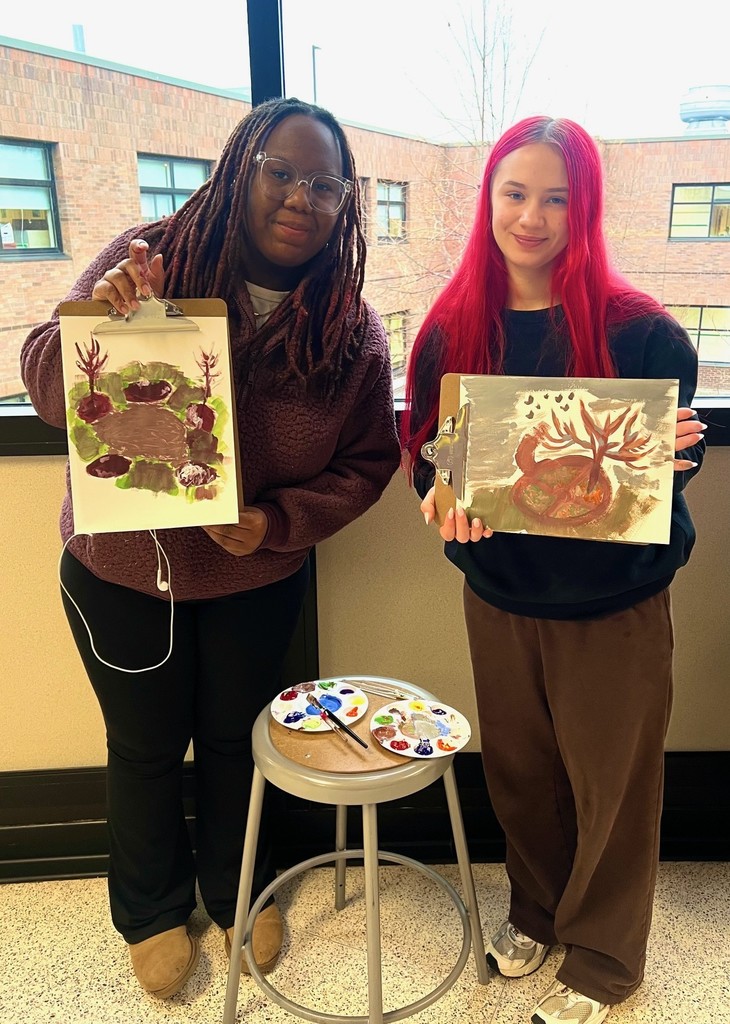
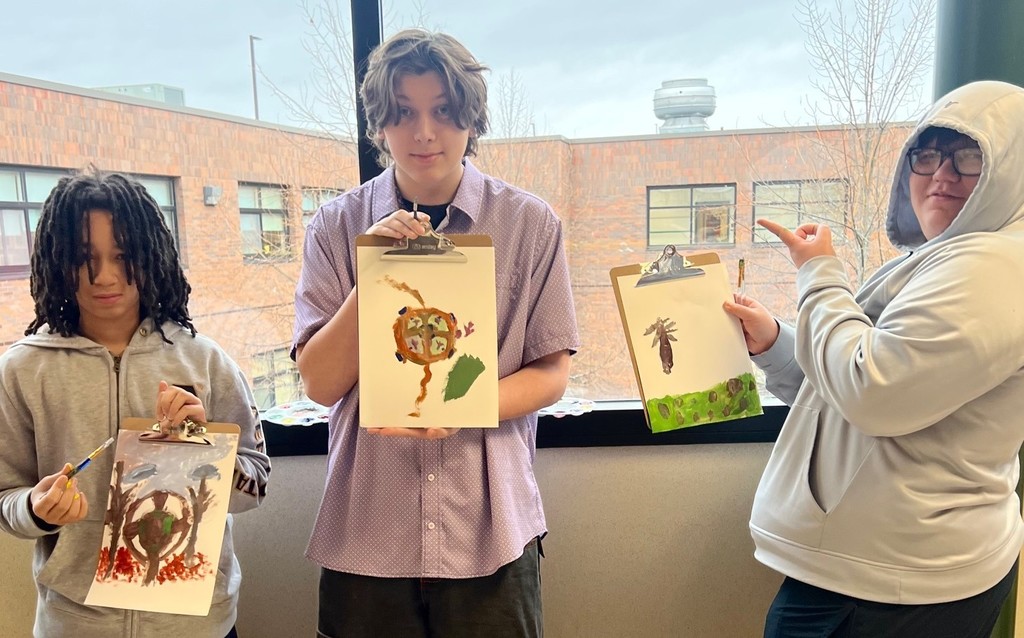

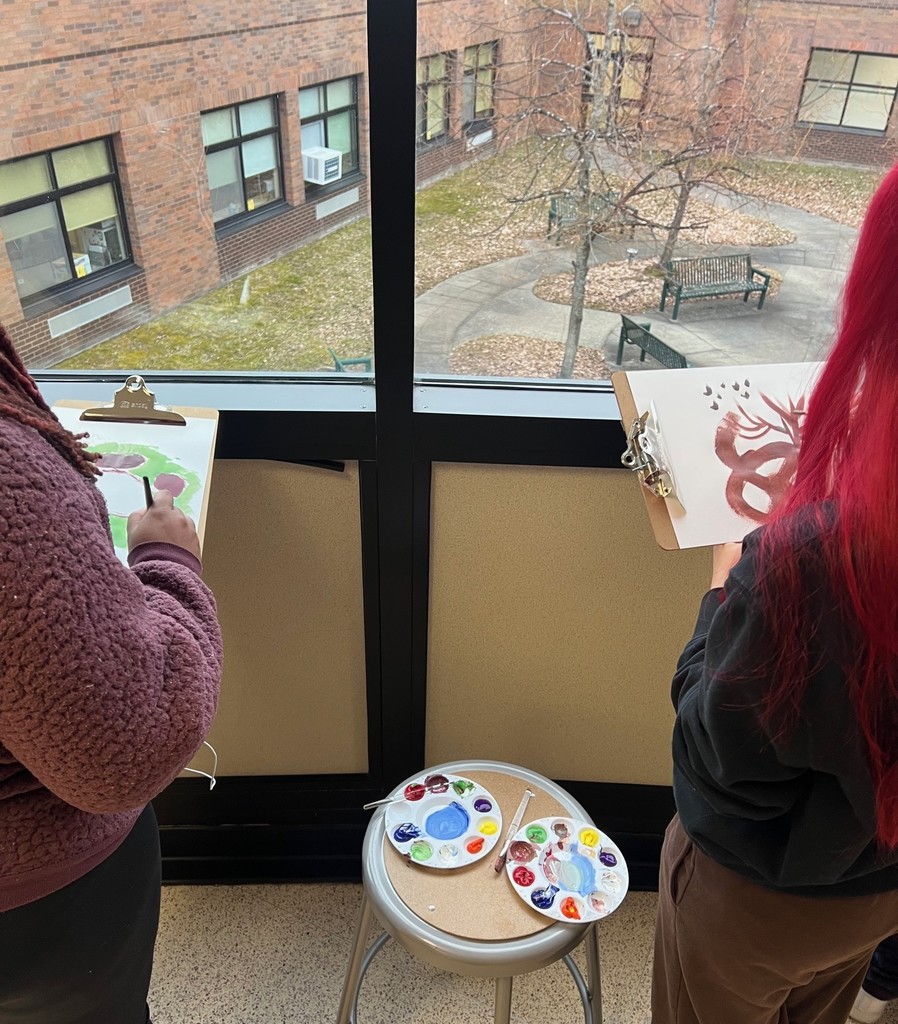
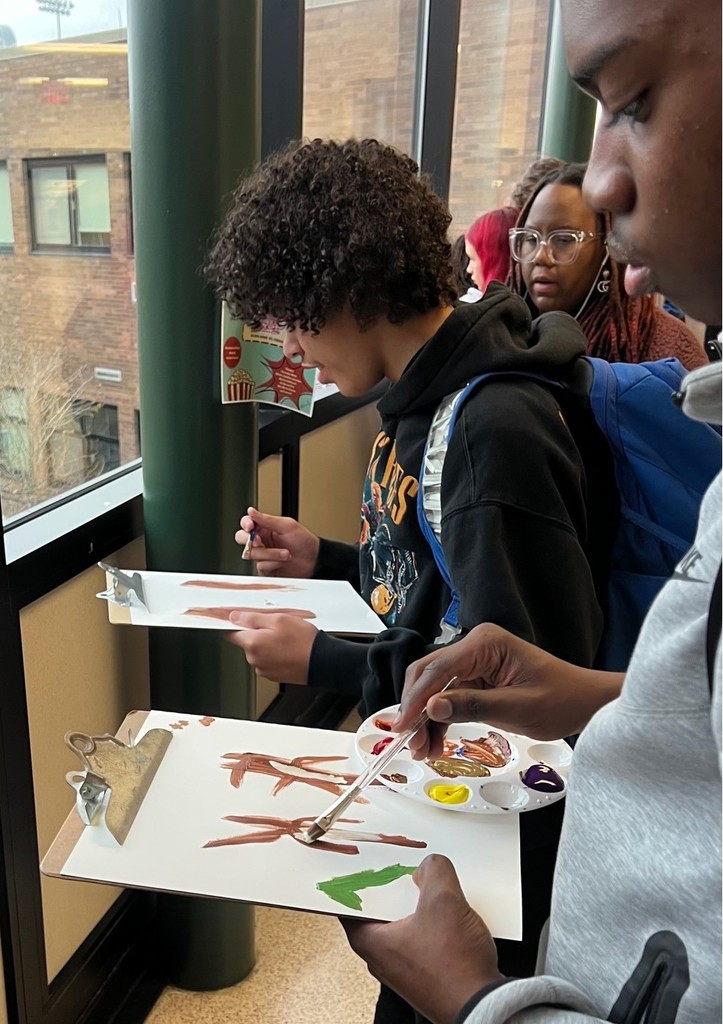

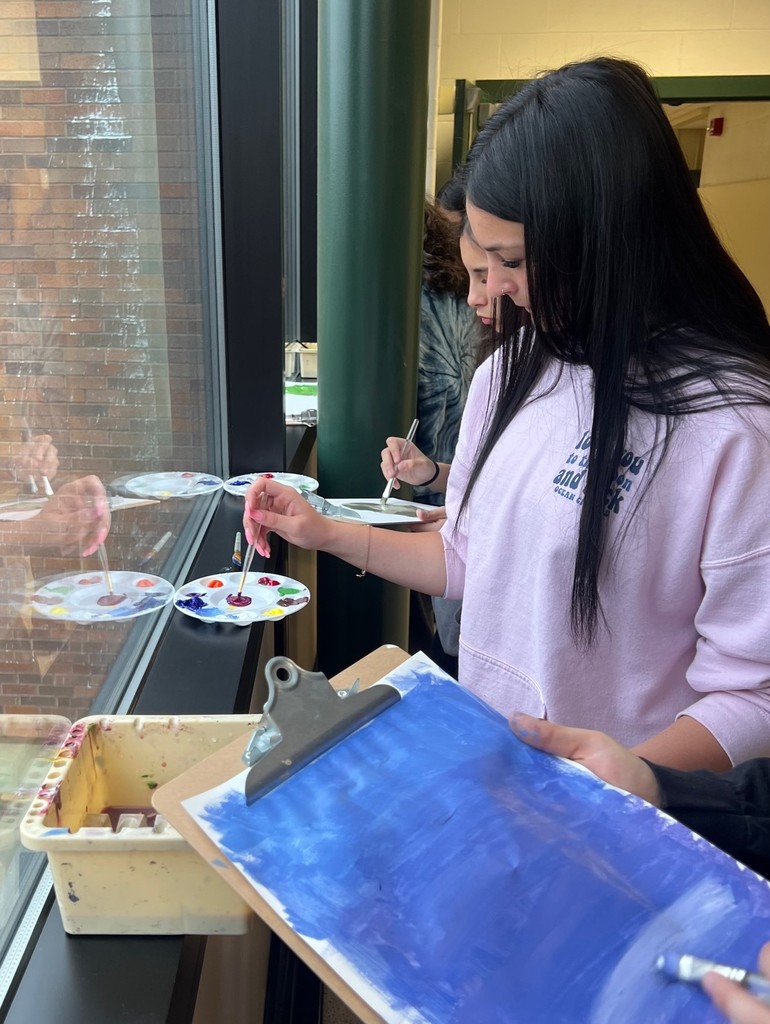
"Top of the morning" to you and Happy Saint Patrick's Day!
Meghan Donahue's ES first-graders have made some spectacular leprechaun traps with the intention of capturing any mischievous leprechauns that may have made their way into their classroom. Students will be arriving shortly, so it'll be interesting to see if any were trapped!
Leprechaun traps are craft projects usually made from household items like boxes, tin cans, or paper, and these little students made
The tradition of leprechaun trapping is similar to the Christmas tradition of leaving cookies out for Santa Claus.
